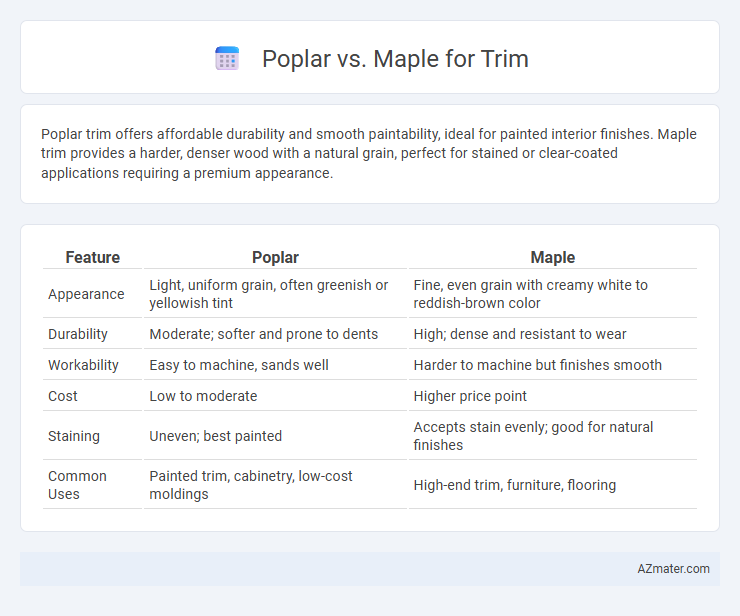Poplar trim offers affordable durability and smooth paintability, ideal for painted interior finishes. Maple trim provides a harder, denser wood with a natural grain, perfect for stained or clear-coated applications requiring a premium appearance.
Table of Comparison
| Feature | Poplar | Maple |
|---|---|---|
| Appearance | Light, uniform grain, often greenish or yellowish tint | Fine, even grain with creamy white to reddish-brown color |
| Durability | Moderate; softer and prone to dents | High; dense and resistant to wear |
| Workability | Easy to machine, sands well | Harder to machine but finishes smooth |
| Cost | Low to moderate | Higher price point |
| Staining | Uneven; best painted | Accepts stain evenly; good for natural finishes |
| Common Uses | Painted trim, cabinetry, low-cost moldings | High-end trim, furniture, flooring |
Introduction to Poplar and Maple for Trim
Poplar and maple are popular hardwood choices for trim due to their durability and smooth finish. Poplar offers a lightweight, cost-effective option with a fine grain, making it ideal for painting and detailed millwork. Maple is denser and harder, providing a sleek, durable surface with natural light tones suitable for staining and high-traffic areas.
Wood Characteristics: Poplar vs Maple
Poplar wood is lightweight with a fine, even texture and a straight grain, making it easy to paint and shape for trim applications. Maple wood, known for its hardness and durability, has a dense, tight grain with a smooth surface that takes stain well but is more challenging to work with. Poplar offers cost-effective versatility and smoothness, while maple provides superior strength and natural beauty for high-end trim installations.
Durability and Strength Comparison
Poplar offers moderate durability and is softer, making it easier to work with for interior trim but less resistant to dents and wear compared to maple. Maple is significantly harder and more durable, ideal for trim in high-traffic areas or where impact resistance is essential. The Janka hardness rating of maple (1450) far exceeds poplar's (540), highlighting its superior strength and long-term performance.
Appearance and Grain Differences
Poplar trim features a light, creamy color with subtle green or gray undertones, offering a smooth, uniform appearance ideal for painting, while maple trim displays a warm, natural color spectrum ranging from creamy white to rosy hues with pronounced, fine-grain patterns that highlight its natural beauty. The grain of poplar is generally straight and consistent, providing a more uniform texture, whereas maple grain can be curly, wavy, or even birdseye, creating a richer, more textured visual effect. Choosing between poplar and maple for trim depends on whether a smooth, paint-ready surface or a naturally elegant, grain-highlighted finish is desired.
Workability and Ease of Installation
Poplar offers excellent workability due to its soft texture, making it easy to cut, shape, and sand, which reduces installation time for trim projects. Maple, while harder and denser, provides a smooth finish but requires sharper tools and more effort during cutting and fitting. Choosing poplar trim simplifies installation for less experienced workers, whereas maple demands precision but results in a more durable and resistant finish.
Cost Comparison: Poplar vs Maple Trim
Poplar trim generally costs significantly less than maple, making it a budget-friendly option for interior projects. While maple trim is prized for its durability and smooth finish, its higher price reflects the quality and aesthetic appeal. Choosing poplar trim offers a cost-effective alternative without sacrificing paintability and ease of installation.
Paint and Stain Compatibility
Poplar is highly favored for trim due to its excellent paint adhesion and smooth surface, making it ideal for painted finishes where a clean, crisp look is desired. Maple offers a harder surface with a tighter grain, which can make staining more challenging but results in a rich, natural wood appearance when properly prepped and sealed. Both woods respond well to primer, but poplar provides more consistent results for paint, while maple excels in stain compatibility for showcasing wood grain.
Maintenance and Longevity
Poplar trim offers low maintenance due to its smooth grain and resistance to dents, making it easier to paint and clean compared to Maple. Maple trim, known for its hardness and density, provides greater longevity but can be more prone to surface scratches and requires more careful upkeep to maintain its appearance. When balancing maintenance and durability, Poplar suits budget-friendly, low-maintenance projects, while Maple excels in long-term wear and sturdiness.
Best Applications: When to Choose Poplar or Maple
Poplar is best for painted trim due to its smooth texture and affordability, making it ideal for interior applications where cost-effectiveness and ease of finishing are priorities. Maple, with its durability and attractive grain, excels in stained or natural finishes, suitable for high-traffic areas or architectural details needing strength and a refined appearance. Choosing poplar is advantageous for budget-friendly, paint-grade trim, while maple is preferred for premium trim requiring long-lasting durability and aesthetic appeal.
Conclusion: Which Trim Wood Should You Choose?
Poplar offers a smooth, paintable surface ideal for budget-friendly, versatile trim applications, while maple provides a harder, more durable option with attractive natural grain suited for staining and high-traffic areas. Choose poplar if you prioritize cost-effectiveness and ease of customization with paint, whereas maple is better for projects demanding strength and a refined finish. Both woods are excellent trim choices, but your selection should align with the desired aesthetic, durability, and budget requirements.

Infographic: Poplar vs Maple for Trim
 azmater.com
azmater.com